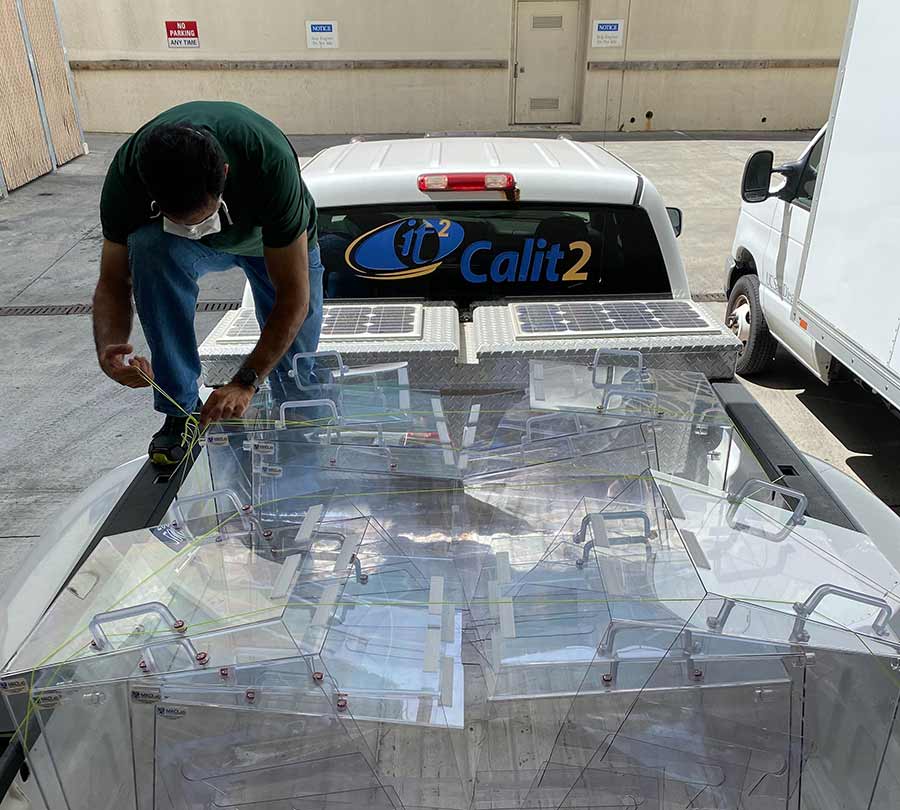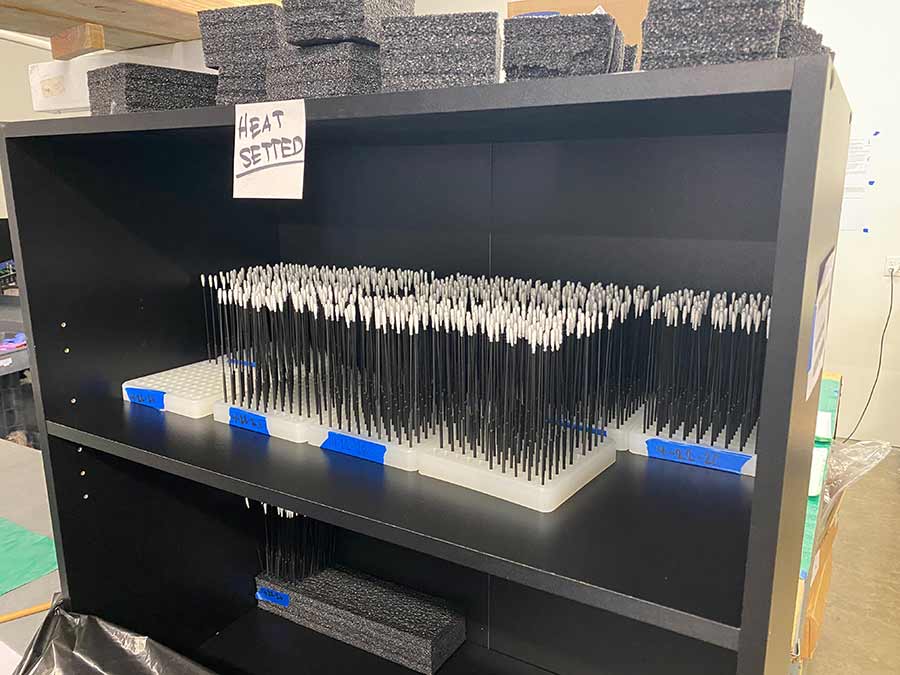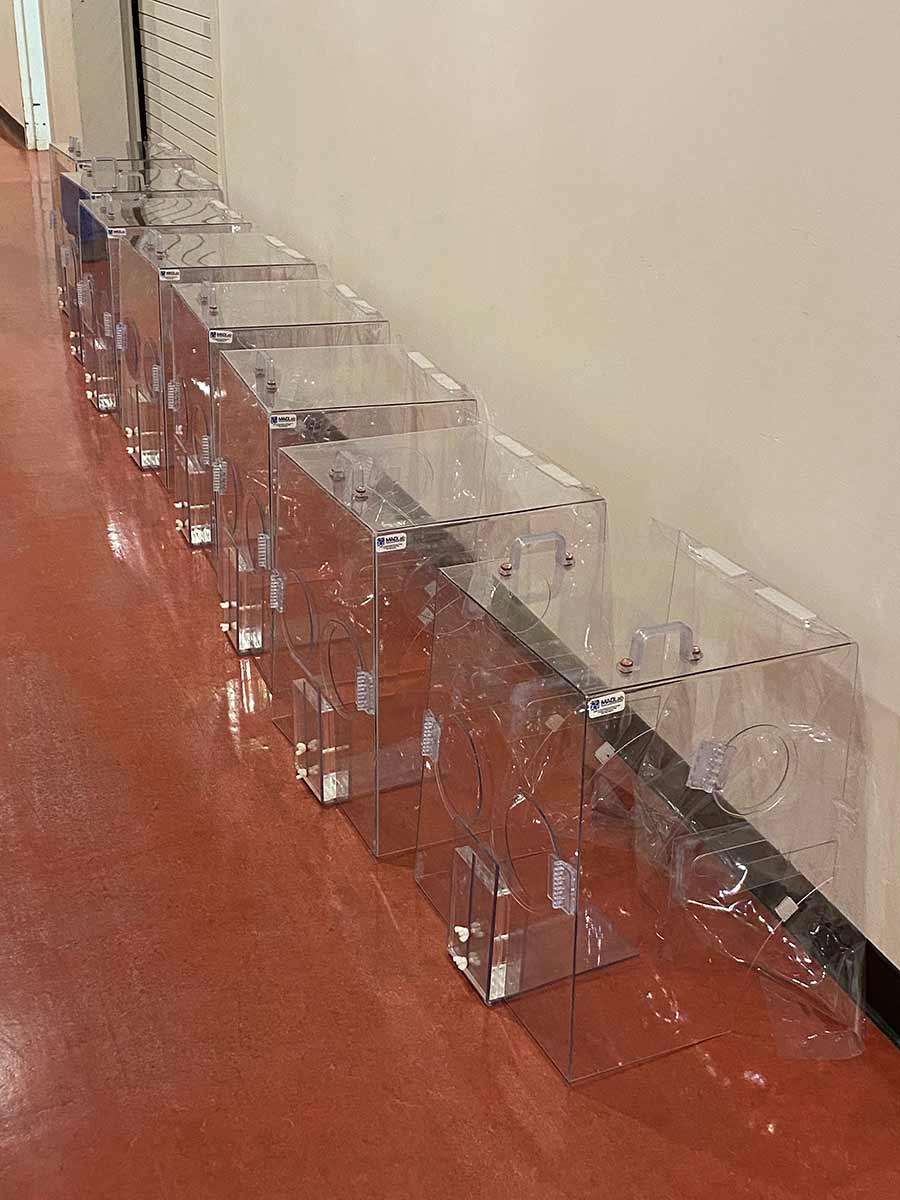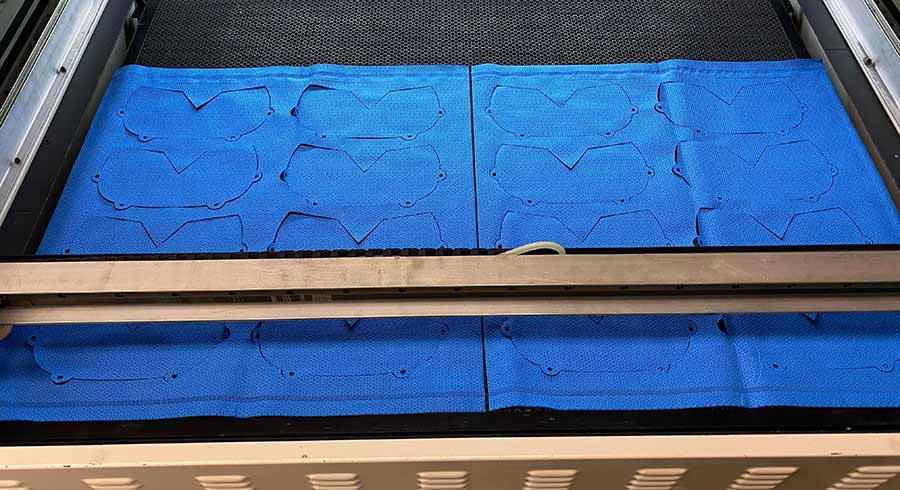Scientists Discover a New Signaling Pathway and Design a Novel Drug for Liver Fibrosis
Health & Behavior
By:
Published Date
By:
Share This:
In the midst of the unprecedented COVID-19 pandemic that had UC San Diego researchers racing to understand the complexities around the virus’s spread and to find ways to combat it, engineers and fabrication specialists at the Qualcomm Institute’s Prototyping Lab leapt into action.

Vacuum exhaused isolation lockers, or VEILs, produced in the Prototyping Lab are ready to be delivered to local hospitals.
The lab’s 3D printers, laser cutters and other machinery along with in-house expertise in mechanical and electrical engineering design, have been tapped by researchers across campus as they seek to protect patients and healthcare workers and provide mass testing for the virus.
“It’s exciting and gratifying to see how much the community has pulled together to help in every way possible during this time,” said Qualcomm Institute (QI) mechanical engineer Alex Grant, who along with Prototyping Lab Director Jeffrey Sandubrae has been stretching the lab’s capacity to help several important initiatives move forward.
“We are pleased to be able to lend our resources in this time of crisis. We have the unique benefit of collaborating with our campus partners and industry to bring an idea to life and create potential solutions that could benefit our community, our region and our world,” Sandubrae said.
Qualcomm Institute Director Ramesh Rao said, “Within our Atkinson Hall, we have developed an infrastructure that can accommodate many diverse projects and groups. We offer not only a unique facility in our Prototyping Lab but the unique expertise of our technical and professional staff.”
The request from Rady Children’s Hospital to the Prototyping Lab began with a simple need for rayon fibers to make testing swabs for COVID-19.
Grant started procuring materials to help the hospital meet the heavy demand for testing, and the lab’s involvement quickly expanded to brainstorming ways to manufacture the swabs themselves.
“The intent was to make as many swabs to meet the needs of Rady’s to begin with, and it’s since evolved. We did some brainstorming and prototypes of different swab geometries using our 3D Markforged printer,” he recalled.

Trays QI mechanical engineer Alex Grant designed and manufactured to hold the swabs in easy-to-count rows to streamline the process throughout the production line.
What resulted was a model of the swab stick that would eventually be wrapped with the rayon fibers at the tip. That prototype of the swab stick then jumpstarted an effort to bring much-needed testing swabs to the area, and possibly the state.
With only so much capacity available in the Prototyping Lab, a local startup with multiple 3D Markforged printers was brought into the fold to begin producing the swab sticks in greater numbers. Grant continued to work with the company on improving the workflow where appropriate and identify any bottlenecks to their process. He designed and manufactured more than 100 trays to hold the swabs in easy-to-count rows to streamline the process throughout the production line.
And what began as just a request for material has turned into a partnership between academia and industry that is providing 5,000 to 6,000 swabs per day to boost Rady’s COVID-19 testing efforts and to support UC San Diego’s Return to Learn initiative that aims to test students, faculty and staff on campus on a recurring basis for the virus. Sandubrae said the company has also been in talks to supply the state with swabs.
The Prototyping Lab is also helping to support the university's Return to Learn program by creating and printing initial prototypes for test tube caps on the lab’s resin-based 3D printer. The caps will be needed for the tubes that will hold the COVID-19 tests conducted on campus. The lab is currently evaluating its potential involvement and making recommendations about production needs and logistics.
With two different Polycarbonate boxes developed in the Prototyping Lab, engineers and doctors are seeking to protect patients and their caregivers.
Grant and the Prototyping Lab were enlisted to help design and develop two enclosures for COVID-19 patients as a part of research teams trying to make treating those patients safer for medical staff and patients themselves.
With the vacuum exhaused isolation locker, or VEIL, researchers have designed and built an enclosure that extracts exhaled aerosols and droplets from COVID-19 patients, providing health care workers with a safety barrier. Grant describes it as a large bubble that goes over a patient’s head and upper body, giving a patient an oxygen-rich environment that also prevents air—and possible droplets contaminated with COVID-19—from leaving the enclosure.
The device helps reduce the need for ventilators while also providing a solution to help patients breathe without suffering the long-term health issues from a ventilator such as lung scarring.

COSIE boxes in the Prototyping Lab hall during production.
Grant was first approached by a graduate student working on the research team and together they worked through 11 different iterations and several small modifications as the team tested the device in local hospitals and clinics. Two versions, one for a hospital bed and the other for a gurney, have been developed.
Twenty-five of these boxes are currently in use at UC San Diego clinics in Hillcrest and La Jolla. The project has been supported by the Qualcomm Institute’s rapid response initiative.
The VEIL team is led by UC San Diego professors Dr. Timothy Morris, a pulmonologist, and James Friend in the Department of Mechanical and Aerospace Engineering. In addition to Sandubrae and Grant from QI, other team members include Mechanical and Aerospace Engineering Ph.D. student Gopesh Tivawala and other physicians and researchers at the Jacobs School of Engineering and the UC San Diego School of Medicine.
Grant helped develop another box—what he describes as a glove box—where a doctor can put his or her hands through two openings and intubate a patient. Called Coronavirus Safety during Intubation and Extubation (or COSIE), the enclosure protects medical staff from aerosols and droplets from COVID-19 patients during intubation and extubation. Grant and Sandubrae again worked with Friend and his Ph.D. student Tivawala as well as Dr. Alexander Girgis, a UC San Diego anesthesiologist, and others to build this device.
Graduate students also approached Grant for his involvement on the COSIE project. Luckily, Grant, whose expertise is in robotics and manufacturing, had made this type of box before and had a decade of experience working with the type of plastic used to construct it.
The group went through six iterations, adjusting the arm holes a couple inches to make it more comfortable and functional and making other modifications.
Between 20 and 30 boxes were built in the Prototyping Lab that were then taken by a San Diego anesthesiologist group to several area hospitals for trials. The team’s findings were recently published in the Journal of Cardiothoracic and Vascular Anesthesia.
The Prototyping Lab has also worked with students and researchers in a project led by Nadir Weibel, an associate professor in the Department of Computer Science and Engineering and head of the Human-Centered and Ubiquitous Computing Lab, to create face masks for hospitals in Tijuana, Mexico.

Facemasks bound for Tijuana hospitals are being cut on the laser cutter in Prototyping Lab.
Weibel and a team of students have created multi-layered fabric face masks fabricated with guidance from Grant and Sandubrae using one of the laser cutters available in their lab.
Sandubrae said a process was developed on the laser cutter that seals the edges as it cuts through the layers of fabric, like cauterizing a wound, and reduces the amount of work needed to create the masks.
“We have been able to produce a surgical mask that has better protection than any other DIY masks out there,” said Weibel, whose team has produced about 1,500 masks to supply hospitals in Tijuana.
Grant and colleague Mark Stambaugh, a QI electrical engineer, were enlisted to help on another project led by Friend to develop low-cost, easy-to-use emergency ventilators for COVID-19 patients.
Grant helped the team with design consulting on the ventilator and then worked with the lab’s 3D printing capabilities to produce several early prototypes. Panels for the ventilator were cut with the lab’s laser cutter and a type of air flow valve was 3D printed, he said. Stambaugh stepped in to work on the microcontroller and help adjust the stroke cycle and control the speed and volume of the compressions to help patients breathe. Stambaugh also designed the circuit, wrote the code and designed the prototype circuit board, Friend noted.
The Prototyping Lab has also been lending its capabilities to support the work of another Atkinson Hall resident, the Additive Rocket Corporation (ARC), which is known for creating 3D printed metal rocket engines. Part of the Qualcomm Institute Innovation Space (or QIIS), ARC is using the lab’s machine shop to create parts for ventilators for a medical device company.
ARC has also used its own 3D metal printer to make ventilator components that are redesigned to allow for rapid production and increased performance and flexibility in hospital settings. ARC's 3D metal printer is among the many resources in Atkinson Hall available for use by the broader community.
Visit Qualcomm Institute’s Prototyping Lab to learn more about its capabilities and services.
Share This:
Keep up with all the latest from UC San Diego. Subscribe to the newsletter today.